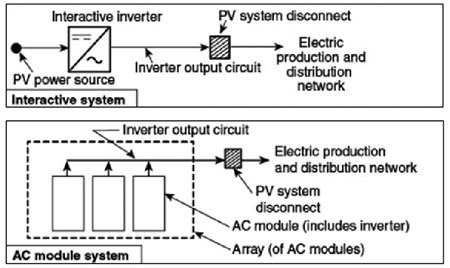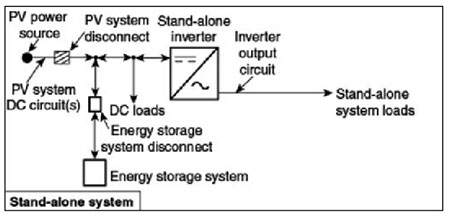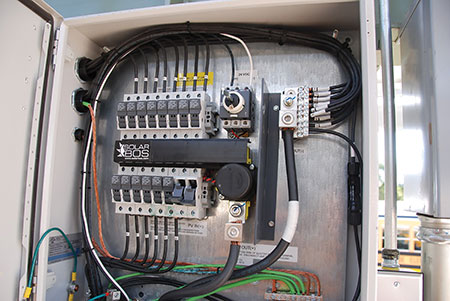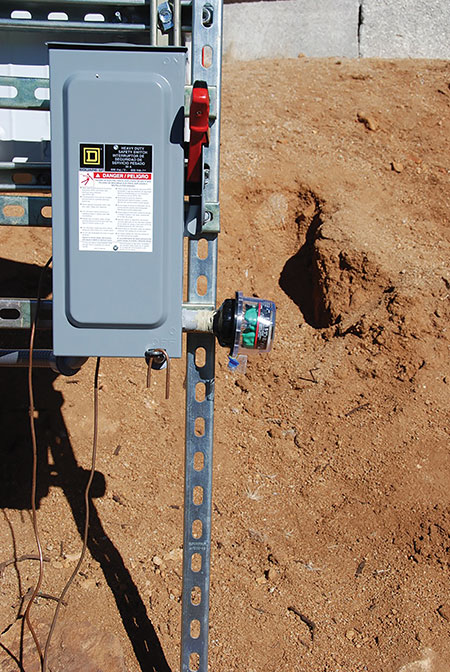Many jurisdictions have now adopted the 2014 NEC and are starting to feel comfortable with the newer photovoltaic (PV) technologies of transformerless inverters and rapid shutdown systems coupled with the code changes required to deal with these and other new devices. I feel sorry for those areas of the country that are still implementing earlier editions of the Code. Why? Because the 2017 NEC has incorporated sweeping changes in the way it deals with PV systems and related systems that will resonate into the future for many years.
CHANGES ARE COMING
Two main areas stand out among the numerous changes that have been accomplished by Code-Making Panel 4 (CMP4) and the NFPA Technical Correlating Committee and its Task Groups. The first major change is a redefinition of what a PV system is and the exclusion or removal of most non-PV system information and requirements from Article 690. The second major change is a redefinition of what is meant by “grounding” and “grounding” requirements as they pertain to PV systems.
PV System Redefined
The first major change to Article 690 is to more narrowly define exactly what a PV system is. As we know them today, PV systems may include several interconnected sources of energy including battery storage systems, multimode inverters, and similar devices. PV system disconnects are located in various locations throughout the “so-called” PV system in a manner that is sometimes confusing. In the new Code, the PV system is primarily concerned and defined as the PV modules and any device connected directly to them that does not involve energy storage or another source of energy. Changes to diagram 690.1 will highlight these differences in the definition of a PV system. Primarily, we are looking at the PV system ending where the PV system disconnect occurs. In the new Code, the PV system disconnect may be either an AC or DC disconnect depending on the configuration of the system. For example, as shown in figure 1, part of Figure 690.1 from the 2017 NEC, the PV system disconnect on a pure utility-interactive PV system occurs at the ac output of the utility-interactive inverter. If there are AC PV modules involved, the PV system disconnect will be at the output of the combined outputs of all of the AC PV modules in the system.


Even though it is acknowledged that the diagrams are not complete, the multimode dc coupled system diagram (figure 2) and the stand-alone system shown (figure 3) are possibly confusing in one aspect. Typically, the output of a PV array cannot be connected directly to a stand-alone or multimode inverter, dc loads, or an energy storage system as shown in these diagrams. If done as shown, the PV voltages to these circuits would be unregulated (changing throughout the day and as clouds appear) and possibly damage the connected equipment. Some sort of charge management device (aka charge controller) is normally used and under the new definitions, that charge management device or system should be grouped with the energy storage system. If that is the case, then the PV system disconnect would properly be connected to an energy storage disconnect and connections to the inverter and any dc loads would be made directly to the voltage-regulated energy storage system/battery through appropriate disconnects. It is anticipated that this oversight will be rectified in future editions of the Code or the second printing of the 2017 NEC.

Also, in the two multimode diagrams (figure 2), the output from the multimode inverter marked “Stand-alone system loads” in the DC-coupled multimode system diagram and not identified at all in the AC-coupled multimode system could probably be more properly identified as “Local ac loads” since they can be powered either by the utility or by the PV/energy storage system when there are utility outages.
As the PV system proper becomes more narrowly identified, parts of Article 690 that deal with other types of electrical systems are moved to other parts of the Code.
Article 706, Energy Storage Systems (ESS) was added to the 2017 NEC, and all of the references to batteries or other energy storage systems previously found in Article 690 will now be in this section. This new section is quite lengthy and has requirements that were not previously in the Code such as a requirement to determine and mark the rated short-circuit current of the ESS. Article 480, Storage Batteries, remains in the Code and has some of the same new or revised requirements that appear in Article 706. Future “Perspectives on PV” will address the requirements in Article 706 in some detail.
Article 712, Direct Current Microgrids was added and has some of the material transferred from sections in Article 690. These requirements should not be confused with the requirements for dc branch circuits in Section 210.5(C)(2).
Article 710, Stand-Alone Systems contains most of the material previously in Article 690 on this subject. The ability of the “Off-Grid” rugged individualist to generate power that is lower than the combined loads has been maintained. In stand-alone installations where there are dc branch circuits used and operate over 50 volts, the requirements of Section 210.5(C)(2) may apply.
Other Definitions Changed/Deleted/Added
In Section 690.2, in addition to Functional Grounded PV systems (described below), other definitions were changed. These include the following new definitions:
- Generating Capacity. The sum of parallel-connected inverter maximum continuous output power at 40°C in kilowatts.
- Interactive Inverter Output Circuit. The conductors between the interactive inverter and the service equipment or another electrical power production and distribution network.
- Photovoltaic System DC Circuit. Any dc conductor supplied by a PV power source, including PV source circuits, PV output circuits, dc-to-dc converter source circuits, or dc-to-dc converter output circuits.
The definition of Photovoltaic Systems Voltage was removed and now appears in Section 690.7.
Several definitions were modified, and they include:
- Inverter Input Circuit. Conductors connected to the dc input of an inverter.
- Inverter Output Circuit. Conductors connected to the ac output of an inverter
GROUNDING—NEW AND OLD
Grounding PV systems has remained essentially unchanged for the most part since PV came to the Code in 1984. However, with the 2017 NEC, the terminology that is used to describe the various grounding functions has been changed. This was done to reduce confusion and simplify terminology between the older “Grounded PV Array/Isolated Inverter” PV systems and the newer, more common “Ungrounded PV array/Non-isolated inverter” PV systems.
Grounding the PV System Circuit Conductors. In the early years of PV, up to about 2005 or so, we primarily had grounded PV arrays and grounded dc battery systems where one of the circuit conductors was “grounded” or “connected” to the grounding system which is composed of the equipment-grounding system, the grounding electrode conductor, and the grounding electrode system. In some cases, the “grounding” method is a solid conductor and in other cases, the grounding method is by a fuse or circuit breaker like those used in Section 690.5 [2014 NEC], Ground Fault Protection. In other cases, various resistances or solid-state devices are used to “ground” one of the circuit conductors.
And now we have increasing numbers of ungrounded PV arrays and non-isolated (transformerless) inverters which have no dc circuit conductors connected directly to ground. Grounded PV systems are becoming a thing of the past, but will exist for years. The required Code requirements to address these varying “grounding” systems are cumbersome, difficult to understand, and hard to apply in many cases. The changes in the 2017 NEC will address and simplify many of these grounding requirements.
Grounding Definitions—2017 NEC.
From the 2017 NEC, some are the same as in the 2014 NEC.
From Article 100
Ground. The earth.
Grounded (Grounding). Connected (connecting) to ground or to a conductive body that extends the ground connection.
Grounded, Solidly. Connected to ground without inserting any resistor or impedance device.
Grounded Conductor. A system or circuit conductor that is intentionally grounded.
From Article 690
Functional Grounded PV System. A PV system that has an electrical reference to ground that is not solidly grounded.
Informational Note: A functional grounded PV system is often connected to ground through a fuse, circuit breaker, resistance device, non-isolated grounded ac circuit or electronic means that is part of a ground-fault protection system. Conductors in these systems that are normally at ground potential may have voltage to ground during fault conditions.
As an aside, my high school English teacher would have objected to the term “functional grounded” and preferred “functionally grounded,” but then she has not seen the rest of the NEC. “Functional ground” would probably have been acceptable.
690.41. PV System Grounding Configurations
One of the following system grounding configurations shall be employed:
(1) 2-wire PV arrays with one functional grounded conductor.
(2) Bipolar PV arrays according to 690.7(C) with a functional ground reference (center tap)
(3) PV arrays not isolated from the grounded inverter output circuit
(4) Ungrounded PV arrays
(5) Solidly grounded PV arrays as permitted in 690.41(B) Exception
(6) PV systems that use other methods that accomplish equivalent system protection in accordance with 250.4(A) with equipment listed and identified for the use.
It should be noted that there are no voltage requirements associated with the requirements in 690.41 and that old 50-volt limit is gone. I suspect it will take some time to figure out what we call these various types of PV arrays. For example, does PV array connected to a non-isolated inverter with a 240 VAC output meet the requirements of (3) since at some point there is a utility transformer that has a grounded 240/120 V center tap?
Equipment Grounding
Sections 690.43, 690.45 and 690.46 dealing with equipment-grounding conductors have remained essentially unchanged.
Grounding Electrode Systems
Section 690.47 on grounding electrode systems has been substantially revised and clarified. The most significant change is for Functional Grounded PV Systems (not solidly grounded). In these systems, the normal ac equipment-grounding conductors from the inverter to the associated distribution system are allowed to serve as the grounding connection for any ground fault protection equipment and for the equipment grounding of the PV array. This is a change from 690.47(C)(3) in the 2014 NEC that required this conductor to meet the requirements of a grounding electrode conductor (bonding, size, and continuity) as well as the requirements for an equipment-grounding conductor.
Also, any building or structure that supports a PV array will have a grounding electrode system (photo 1). The PV array equipment-grounding conductors will be connected to that grounding electrode system, and it appears that grounding electrode system may be the existing site grounding electrode system if one exists. These PV array equipment-grounding conductors are in addition to the normal PV source and output circuit equipment-grounding conductors that are routed with the dc circuit conductors.

Solidly grounded systems will require a grounding electrode conductor per Section 250.166 connected to the grounding electrode system and the grounding electrode conductor or main bonding jumper will be connected at any point on the PV output circuit (690.42).
Additional details on equipment and functional grounding will be addressed in future “Perspectives on PV” articles.
PV Circuit Overcurrent Protection and Disconnects
Section 690.9(C) now permits (note: not a mandatory “shall” or “will”) a single overcurrent protective device(s) (OCPD) to be used in DC PV source and DC PV output circuits to protect the modules and circuit conductors even on ungrounded PV arrays where both circuit conductors, positive and negative, are ungrounded. No longer are OCPD required in both ungrounded conductors. However, the OCPD in dc combiners and in other locations in the system must be in the same polarity conductor. See photo 2.

Section 690.13(F)(1) requires that all types of PV systems have a disconnecting means that simultaneously opens all conductors (even those solidly or functionally grounded) of the PV system from all conductors of other systems (photo 3). It is not clear, at this time, if the PV disconnect must open the grounded neutral conductor of the ac output of utility-interactive inverters, and if so, does the PV system remain functionally grounded when the disconnect is opened? And, is that now ungrounded neutral conductor in any way involved with safety and performance of the non-isolated inverter?

Section 690.31(B)(1) allows a white conductor marking on only those circuit conductors that are solidly grounded. However, it may be a safety issue on a solidly grounded PV array with white conductors to the array that has the required PV disconnect that must open that grounded conductor. When the disconnect is opened, that marked white conductor is still grounded but the conductor to the connected equipment, which may be an energy storage system is now ungrounded. Should this conductor be marked white?
HELP FOR THE SYSTEMS DESIGNER FROM THE PROFESSIONAL ENGINEER (P.E.)
Article 690. On the larger PV systems (100 kW and larger), some of the general requirements for voltage and current calculations are too conservative for the proper and safe installation of cost-effective PV systems.
Section 690.7(A)(3) allows the P.E. to calculate the maximum system voltages based on industry design practices that might include such factors as microclimates, array mounting devices, and array orientation. This new calculated system voltage may permit more modules to be placed in series than the more conservative 690.7(A)(1) & (2) would allow.
Section 690.8(A)(2) allows the P.E. to calculate a maximum current that can be no less than 70% of maximum current calculated using the normal method of using 125% of the short-circuit current (Isc). In large systems, these methods using simulated local irradiance may allow smaller, yet still safe, conductor sizes.
Article 691. For large-scale (5 megawatts or greater) PV systems, not under the ownership or operation of a utility, special design and installation requirements are allowed. These requirements address numerous areas, but in general require a P.E. engineered design, limited and controlled access, no local loads except as necessary to operate the generation system and a full, utility-type substation to make the connection to the local utility. Also, parts of the system that do not comply with the requirements of Article 690 shall be fully justified and documented.
At the request of the AHJ, an independent P.E. or other organization, retained by the system owner, may be required to evaluate the actual installation for compliance with the Code requirements and the engineered design.
Even though these large systems (in Articles 690 and 691) are designed by a P.E., and may have independent review of the installation for compliance with the design, it is still the responsibility of the AHJ to ensure that the system is safe and meets the various applicable codes. Keep in mind that all of the large utility-scale systems being installed today use engineered designs, but Scott Humphrey’s excellent series of articles on inspecting large PV systems in recent editions of the IAEI News point out the continuing need for close and detailed inspections of these installations by the AHJ supervising a team of inspectors.
Summary
As can be seen from this quick look at the PV requirements in the 2017 NEC, there are many new concepts and requirements to consider. The first PV installers and AHJs to deal with the new Code will have to agree on what the requirements mean and how they will be implemented. Real-world applications of the written Code requirements may reveal situations that are more complex than can be addressed by the Code requirements. Stand by. Time will tell.
Please note that this article was written in August 2016 and was based on the Second Draft of the 2017 NEC. The published Code may reflect last minute changes.
For More Information
The author has retired from the Southwest Technology Development Institute at New Mexico State University but is devoting about 25% of his time to PV activities to keep involved in writing these “Perspectives on PV’ articles in the IAEI News and to stay active in the NEC and UL Standards development process. Seven- to eight-hour presentations are still available on PV and the Code, and they cover 2008-2014 NEC requirements. He can be reached at e-mail: jwiles@nmsu.edu, phone: 575-646-6105
The Southwest Technology Development Institute web site maintains a PV Systems Inspector/Installer Checklist and all copies of the previous “Perspectives on PV” articles for easy downloading. A color copy of the latest version (1.93) of the 150-page, Photovoltaic Power Systems and the 2005 National Electrical Code: Suggested Practices, written by the author, may be downloaded from this website: https://swtdi.nmsu.edu/codes-standards/











Find Us on Socials